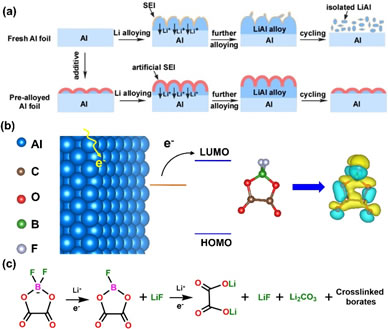Recently, Tang Yongbing, a researcher of the Functional Thin Film Materials Research Center of the Institute of Integration, Chinese Academy of Sciences, Shenzhen Institute of Advanced Technology, and his team proposed a strategy to improve the high-capacity aluminum metal anode by synchronizing prealloying and constructing a synthetic solid electrolyte interface (SEI) film The stability, and successfully used in high-performance lithium-ion hybrid capacitors. Related research achievements: Simultaneously pre-alloying and artificial solid electrolyte interface towards highly stable aluminum anode for high-performance Li hybrid capacitor The title was published online in the International Materials Journal Energy Storage Materials.
Compared with traditional graphite anodes, alloyed anodes such as silicon, aluminum, and tin have a high theoretical specific capacity, which is beneficial to further increase the energy density of the battery. Taking aluminum anode as an example, its alloying capacity reaches 993 mAh g-1 (LiAl), which is about 2.7 times that of graphite anode. However, alloyed anodes often face severe volume expansion during charging and discharging (Si: ~ 300%; Al: ~ 97%; Sn: ~ 260%), resulting in electrode powdering and poor battery cycle stability .
In view of this, Tang Yongbing and his team members Ou Xuewu, Zhang Ge and others investigated the matching behavior of different additives and a variety of negative electrodes, and selected a fluorine-containing lithium salt (LiDFOB) as an additive for the simultaneous pre-alloying of aluminum negative electrodes and Construct artificial solid electrolyte interface (SEI) membrane treatment. The additive can be polymerized by a ring-opening reaction, which helps to form an artificial SEI film rich in LiF on the surface of the aluminum negative electrode, thereby improving the stability of the SEI film. In addition, the LiAl alloy layer can compensate for the irreversible loss of lithium ions during charge and discharge, thereby improving the cycling performance of the aluminum anode. After matching the modified aluminum negative electrode with the activated carbon positive electrode, a new type of lithium-ion hybrid capacitor was successfully constructed. The hybrid capacitor showed a specific capacity of up to 123.6 mAh g-1 in the voltage range of 1.5-4.5 V and excellent Cyclic stability, the capacity retention rate after 2000 cycles is ~ 86%. This work is of guiding significance for optimizing the stability of alloyed anodes and constructing new energy storage devices.
The research was supported by the National Natural Science Foundation of China, the Guangdong Science and Technology Plan, and the Shenzhen Science and Technology Plan.

(A) Mechanism of improving the cycle stability of aluminum anode by synchronous prealloying and constructing artificial SEI film; (b) DFOB-reduction mechanism on the surface of aluminum anode and DFOB-charge difference diagram after accepting electrons; (c) DFOB- Mechanism of reduction and polymerization through ring-opening reaction
Router Tools, Wood Router, Plunge Router, Hand Router, Router for Wood, Router Cutter, Electrical Router, Woodworking Router, CNC Router
YongKang WALMA Tools CO., LTD. , https://www.walmatools.com